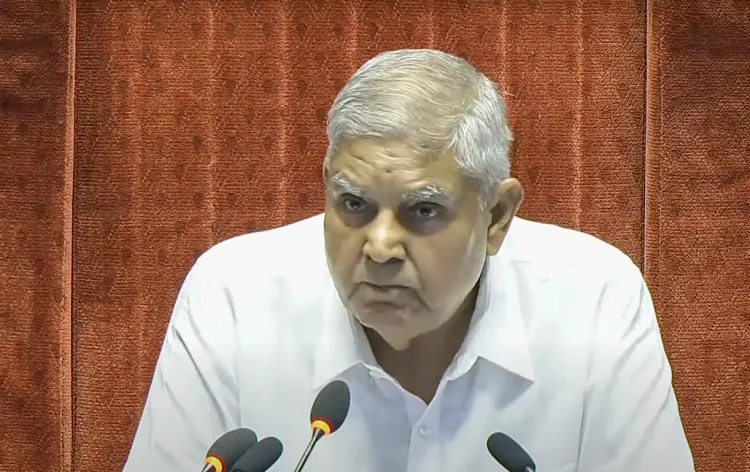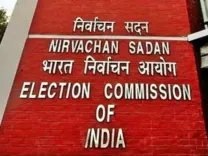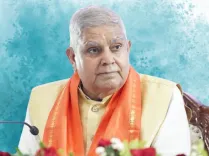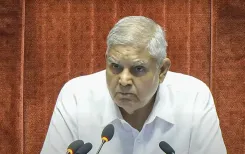What’s Next After Vice President's Mid-Term Exit?

Synopsis
Key Takeaways
- Jagdeep Dhankhar's resignation initiates a constitutional transition.
- The Deputy Chairman will temporarily preside over the Rajya Sabha.
- The election for a new Vice President must occur within six months.
- Dhankhar's departure could change the parliamentary engagement tone.
- The upcoming elections will influence the choice of successor.
New Delhi, July 21 (NationPress) The resignation of Vice President Jagdeep Dhankhar has triggered a significant constitutional and political transformation that will unfold in the upcoming weeks.
With his resignation now finalized, the election process for a new Vice President—who holds the second-most important constitutional position in India—will commence as per Article 66 of the Constitution.
In the interim, the Deputy Chairman of the Rajya Sabha will fulfill the Vice President's parliamentary responsibilities, which include presiding over sessions in the Upper House. However, this temporary arrangement does not grant the title of Acting Vice President or extend broader constitutional authority beyond the chairmanship of the Rajya Sabha.
According to the Constitution, the Election Commission is required to fill the vacancy “as soon as possible,” usually within a period of six months. The newly elected Vice President will serve a complete five-year term instead of merely finishing the remaining term of Dhankhar, as clarified by Supreme Court lawyer Pradeep Yadav.
Currently, Dhankhar is not anticipated to retain any official capacity. Once his resignation is formally submitted to the President under Article 67(a), the position becomes vacant, and there are no provisions for an interim return unless a new election is conducted.
This transitional phase in Rajya Sabha leadership coincides with a politically charged atmosphere during the Monsoon Session, a time typically marked by heightened legislative activity.
Dhankhar’s departure eliminates a vocal and confrontational presence from the Upper House, potentially shifting the dynamics of parliamentary discussions. The Deputy Chairman, while fully competent, may adopt a more tempered approach compared to Dhankhar’s assertive demeanor.
As the government deliberates its successor, the nomination will not only reflect strategic calculations ahead of the 2026 general elections but also influence the desired tone of parliamentary dialogue.
This period presents the Opposition with a brief opportunity to recalibrate strategies and possibly advocate for a less partisan individual to assume this constitutional role.
The outcome of the Vice Presidential election—and its immediate repercussions on the functioning of the Rajya Sabha—will have enduring consequences for both governance and the evolving dynamics of Indian democracy.
In the meantime, the Deputy Chairman will preside over the Upper House proceedings. However, this is merely a procedural arrangement and does not elevate the Deputy Chairman to the status of Acting Vice President.
As clarified by advocate Pradeep Yadav, the resignation does not initiate a constitutional crisis—such crises are typically linked with the office of the President. Nonetheless, constitutional offices like the Vice President, Prime Minister, or President must not be left unoccupied.
Having submitted his resignation under Article 67(a), Dhankhar is not expected to hold any position until a successor is appointed. His exit during the Monsoon Session, a time of significant legislative activity, creates a notable vacuum in the Rajya Sabha leadership.
Dhankhar, recognized for his confrontational parliamentary style and close ties to the ruling BJP-led NDA, was frequently at the center of heated debates and procedural disputes.
His absence may momentarily alter the atmosphere of the Upper House, possibly paving the way for a more subdued or conciliatory approach, depending on how the Deputy Chairman navigates the role.
From a political standpoint, the race to appoint a new Vice President offers the NDA a chance to reaffirm its legislative position ahead of the 2026 general elections. A nominee reflecting Dhankhar’s assertiveness could indicate a continuation of combative parliamentary tactics, while a more moderate figure might suggest strategic recalibration.
For the Opposition, this moment provides a rare opportunity to push for a less partisan occupant, though they remain numerically disadvantaged in both Houses. Beyond procedural ramifications, Dhankhar’s resignation underscores the pressures associated with high constitutional offices.
He is the third Vice President in Indian history to resign mid-term, following VV Giri and R Venkataraman, both of whom resigned to assume the presidency. However, Dhankhar appears to have exited public life permanently, showing no signs of a future political pivot.
As Parliament gears up for a leadership transition in the Rajya Sabha, political observers are closely monitoring developments. The government’s choice of successor will not only reflect electoral calculations but also shape future legislative dialogues and the ongoing evolution of India’s constitutional institutions.





